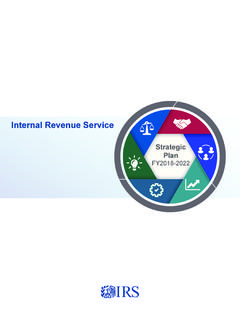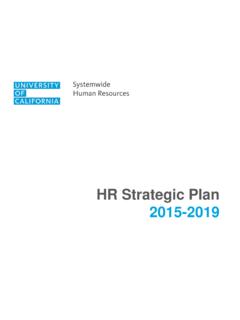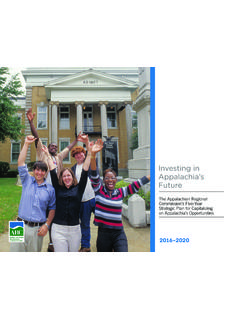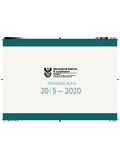Transcription of FY 2018-2022 EPA Strategic Plan
1 Working Together FY 2018 -2022 EPA Strategic plan February 2018 EPA s Mission Protect Human Health and the Environment Goal 1 Core Mission: Deliver real results to provide Americans with clean air, land, and water, and ensure chemical safety. Goal 2 Cooperative Federalism: Rebalance the power between Washington and the states to create tangible environmental results for the American people. Goal 3 Rule of Law and Process: Administer the law as Congress intended, to refocus the Agency on its statutory obligations under the law. Table of Contents Introduction.
2 4 Goal 1: Core Mission ..6 Objective : Improve Air Objective : Provide for Clean and Safe Water ..11 Objective : Revitalize Land and Prevent Contamination ..15 Objective : Ensure Safety of Chemicals in the Marketplace ..19 Goal 2: Cooperative Federalism ..24 Objective : Enhance Shared Accountability ..26 Objective : Increase Transparency and Public Participation ..30 Goal 3: Rule of Law and Process ..34 Objective : Compliance with the Law ..36 Objective : Create Consistency and Certainty ..39 Objective : Prioritize Robust Objective : Streamline and Modernize.
3 46 Objective : Improve Efficiency and Effectiveness ..48 The GPRA (Government Performance and Results Act) Modernization Act of 2010 directs agencies to consult with the Congress and requires that they solicit and consider the views and suggestions of those entities likely to be interested in or potentially affected by a Strategic plan . Consultation with EPA s federal, state, tribal, and local government partners and its many stakeholders is integral to the Agency s Strategic planning process. In developing the FY 2018 -2022 EPA Strategic plan , EPA issued a Federal Register notice and used to encourage and share feedback on the draft plan .
4 The Agency also sent notifications on the availability of the draft plan to leaders of the Agency s Congressional authorizing, appropriations, and oversight committees, and notified all federally-recognized Indian tribes of the opportunity for consultation and coordination. These outreach efforts resulted in unique submissions from approximately 5,000 organizations and individuals. 2 Message from EPA The Environmental Protection Agency s FY 2018 FY 2022 Strategic plan emphasizes the EPA s Back-to-Basics agenda.
5 The agenda set out in this plan has three over-arching goals: (1) refocus the agency back to its core mission; (2) restore power to the states through cooperative federalism; and (3) lead the agency through improved processes and adhere to the rule of law. The agency s mission of protecting human health and the environment reso-nates with all Americans; we all can agree that we want our future generations to inherit a cleaner, healthier environment that supports a thriving economy. Our nation has made great progress in making rivers and lakes safer for swim-ming and boating, reducing the smog that clouded city skies, cleaning up lands that were once used as hidden chemical dumps and providing Americans greater access to information on chemical safety.
6 However, we still have important work to do. We must create a sense of shared accountability between states, tribes and the federal government to achieve positive environmental results. Along with faithfully following the rule of law, improving the processes by which the EPA has operated is crucial in advancing the agency s mission. Air Over the next five years, the EPA will prioritize key activities to support attain-ment of the national ambient air quality standards (NAAQS) and implementation of stationary source regulations. We will work with our state and tribal partners to rapidly approve their imple-mentation plans for attaining air quality standards to reduce contaminants that cause or exacerbate health issues.
7 Water We will modernize and update aging drinking water, wastewater and storm-water infrastructure which the American public depends on. The agency will continue to leverage the State Revolving Funds (SRFs) and Water Infrastructure Finance and Innovation Act (WIFIA) to assist states, tribes, mu-nicipalities and private entities to finance high-priority infrastructure investments that protect human health and the environment. Land The Administration is placing particular emphasis on the top priority list of Superfund sites and will implement Superfund Task Force recommendations to accelerate the pace of cleanups and promote site reuse, while addressing risks to human health and the environment.
8 The agency will accelerate cleanup by re-prioritizing some resources to focus on remedial actions, construction com-pletions, ready-for-reuse determinations and National Priorities List site deletions. 3 Chemicals We will prioritize the safety of chemicals in the marketplace in the implementation of the new Frank R. Lautenberg Chem-ical Safety for the 21st Century Act, which modernizes the Toxic Substances and Control Act (TSCA). To achieve this, the EPA will focus on meeting its statutory requirements and mandatory deadlines of TSCA and ensure our reviews are efficient, effective and transparent to stakeholders.
9 More than 45 years after the creation of the EPA most states, and to a lesser extent territories and tribes, are autho-rized to implement delegated federal environmental programs within their jurisdictions. Recognizing the congres-sionally intended responsibilities of our state, local and tribal partners, we must adapt and modernize our practices to reduce duplication of effort and tailor oversight of delegated programs. For example, the EPA will expand its compliance assistance work by continu-ing to partner with third-party organi-zations and federal agencies to support existing web-based, sector-specific compliance assistance centers and seek to develop new centers.
10 EPA will assess our shared governance to clarify the agency s statutory roles and respon-sibilities and tailor state oversight to maximize our return on investment and reduce burden on states. Over the next five years, the EPA will improve its processes and reinvigorate the rule of law as it administers environ-mental regulations as Congress intended and will refocus the agency on its core statutory obligations. Federal agencies exist to administer laws passed by Congress, in accordance with the will of this body. The EPA will ensure compliance with the law by providing consistency and certainty for the regulated community and clarify the impact of proposed actions on human health, the environment and the econo-my to provide a clear path and timeline for entities to achieve compliance.

















